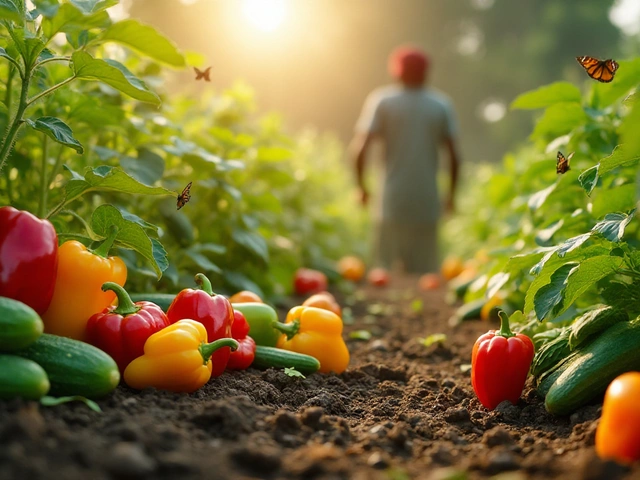Which Vegetable Is the King of Vegetables in India? The Real Answer for Gardeners

Which Vegetable Is the King of Vegetables in India? The Real Answer for Gardeners
Tomato Yield Calculator for Indian Gardens
Calculate Your Tomato Harvest
Estimate your yield based on Indian gardening practices. The article states: "A single plant can give you 10–15 kg of fruit over a season if cared for properly."
Based on Indian gardening practices: Winter yields (10-15 kg/plant), Summer yields (5-8 kg/plant)
Ask any Indian home cook what the most important vegetable is, and they won’t hesitate. It’s not the spicy chili, the fragrant curry leaf, or even the humble potato. It’s the tomato. In Indian kitchens, from the bustling streets of Mumbai to quiet village homes in Uttar Pradesh, the tomato isn’t just a vegetable-it’s the backbone of flavor. And in vegetable gardening across India, it’s the crop that every gardener, beginner or expert, tries to grow first.
Why Tomato Reigns as the King
Tomatoes grow everywhere in India. They thrive in the warm, dry winters of Punjab, the humid monsoon soils of Kerala, and the terrace gardens of Delhi. Unlike other vegetables that need perfect conditions, tomatoes adapt. They can be grown in pots, in raised beds, even in recycled buckets. You don’t need a large plot. A single plant can give you 10-15 kg of fruit over a season if cared for properly.
Indian curries, chutneys, dals, and even breakfast dishes like poha or upma rely on tomatoes for depth. No masala base is complete without sautéed tomatoes. The acidity cuts through rich spices. The natural sugars balance heat. The texture thickens gravies without flour or cream. Even vegetarian families who avoid dairy use tomatoes to add body to their meals.
According to the Indian Council of Agricultural Research, tomato production in India exceeded 20 million metric tons in 2024-more than any other vegetable. It’s grown in all 28 states. Farmers sell it in weekly markets by the basket, not by the kilo. It’s cheap, abundant, and essential.
How Indian Gardeners Grow Tomatoes
Most home gardeners in India start tomato seeds indoors in small pots around September or October. The seedlings are transplanted by late October, just before the cool season kicks in. This timing avoids the monsoon’s fungal diseases and the scorching summer heat.
They use compost-rich soil, often mixed with cow dung or vermicompost. The plants get at least six hours of direct sun. Watering happens early in the morning, never from above-dripping water on leaves invites blight. Gardeners pinch off side shoots to focus energy on fruit. They tie stems to bamboo stakes or trellises, even in small balconies.
Common varieties grown at home include:
- Arka Vikas-resistant to diseases, high yield
- Pusa Ruby-bright red, sweet flavor, great for chutney
- Co-2-early maturing, good for short growing seasons
- Local heirlooms-like the tiny, tart ‘Kashmiri Tomato’ or the meaty ‘Bangalore Round’
Many gardeners avoid chemical pesticides. Instead, they spray neem oil every 10 days. They plant marigolds nearby to repel aphids. A handful of crushed eggshells at the base of the plant prevents blossom end rot.
Other Contenders for the Crown
Some argue that brinjal (eggplant) deserves the title. It’s used in hundreds of regional dishes-baingan bharta in North India, kathirikai kootu in Tamil Nadu, brinjal curry in Bengal. It’s deeply cultural. But brinjal is fussy. It needs warm soil, consistent moisture, and plenty of space. It doesn’t grow well in pots. And it’s prone to pests like the fruit and shoot borer.
Onions? Absolutely vital. They’re the base of almost every savory dish. But onions are harvested dry and stored for months. They’re a pantry staple, not a daily garden harvest. Tomatoes, on the other hand, are picked fresh almost every day during peak season.
Chilies? They bring heat, but not bulk. You don’t need a kilo of chilies to flavor a pot of dal. You need half a kilo of tomatoes.
Even pumpkin and bottle gourd, which grow wild in Indian backyards, are seen as side dishes. They’re seasonal. Tomatoes are year-round in the Indian kitchen.

The Tomato’s Role Beyond the Plate
Tomatoes aren’t just food. In rural India, women often sell surplus tomatoes at local markets. A single plant can earn a family ₹200-₹500 a week during peak season. That’s enough to buy school supplies or medicine.
Many NGOs in Odisha and Bihar teach women to make tomato paste and sun-dried tomatoes as income-generating activities. These products last for months and sell at premium prices in urban markets.
Even in urban apartments, tomato plants are symbols of self-reliance. A balcony with three tomato plants means you never have to buy them. In cities where vegetables cost ₹80-₹120 per kg, growing your own saves ₹3,000-₹5,000 a year.
What Happens When You Skip the Tomato
If you plant only onions, chilies, and spinach in your Indian vegetable garden, your meals will taste flat. You’ll miss the natural umami that tomatoes provide. You’ll end up using more salt, sugar, or store-bought masalas to compensate.
And without tomatoes, you lose the chance to make simple, fresh chutneys-like the one made with green tomatoes, garlic, and mint. Or the summer salad with sliced tomatoes, onions, and lemon juice. These are everyday meals that define Indian home cooking.
Tomato plants also attract pollinators. Bees and butterflies love their yellow flowers. In urban gardens, they’re often the only thing that brings life to a concrete balcony.

Final Verdict: Tomato Is the King
There’s no debate among Indian gardeners. The tomato is the king. Not because it’s the most expensive or the largest. But because it’s the most reliable, the most versatile, and the most loved.
It doesn’t demand perfection. It gives generously. It connects rural farms to urban kitchens. It turns a small patch of soil into a source of daily nutrition, flavor, and even income.
If you’re starting a vegetable garden in India, plant tomatoes first. Plant them in pots, in soil, on rooftops, in corners. They’ll reward you every day with color, taste, and purpose.
Frequently Asked Questions
Why is tomato called the king of vegetables in India and not in other countries?
In countries like the U.S. or Germany, tomatoes are often treated as fruits in culinary terms and used more in salads or sandwiches. In India, tomatoes are a foundational cooking ingredient-used in almost every savory dish, from breakfast to dinner. Their role in building flavor depth makes them indispensable, which is why they’re elevated to king status here.
Can I grow tomatoes in India during summer?
It’s hard. Temperatures above 35°C cause tomato flowers to drop and fruit to rot. Most Indian gardeners avoid summer planting. The best time is October to March. If you must grow in summer, choose heat-tolerant varieties like ‘Arka Srijan’ and use shade cloth. Water early and mulch heavily.
What’s the easiest tomato variety for beginners in India?
‘Pusa Ruby’ is the top choice. It’s disease-resistant, grows well in pots, and produces medium-sized, sweet tomatoes in about 60 days. It’s widely available in seed stores across India and doesn’t need complex care.
Do tomatoes need fertilizer in Indian soil?
Yes, but not chemical ones. Indian soils are often rich in organic matter, especially if you use compost or cow dung. Add a handful of bone meal or neem cake at planting time. After 4 weeks, feed with diluted cow urine or compost tea every 10 days. Avoid NPK chemical fertilizers-they hurt soil microbes and reduce flavor.
Why do my tomato plants have lots of leaves but no fruit?
That’s usually too much nitrogen or not enough sunlight. If your plant is lush and green but not flowering, cut back on compost or manure. Make sure it gets at least 6 hours of direct sun daily. Also, gently shake the flowers around noon-this helps pollination. No bees? Do it yourself with a soft brush.
About
Gardener Support India is your go-to online destination for expert advice on gardening and horticultural services in India. Whether you're a beginner or an experienced gardener, our platform offers extensive resources, tips, and support tailored to Indian climates and plant species. Explore a wide range of guides on plant care, sustainable gardening practices, and innovative gardening solutions. Connect with local experts to enhance your gardening experience and maintain a flourishing garden. Our dedicated services aim to empower Indian gardeners with the knowledge and tools needed for a successful gardening journey.
Latest Posts


Best Months for Flower Blooming in India: Flower Seasons & Tips
By Alden Thorne Jul 27, 2025

Most Beautiful Flower in the World: Types, Facts, and Gardening Tips
By Alden Thorne Jul 31, 2025

Top Shade-Loving Plants for Your Balcony Garden
By Alden Thorne Apr 13, 2025

Write a comment